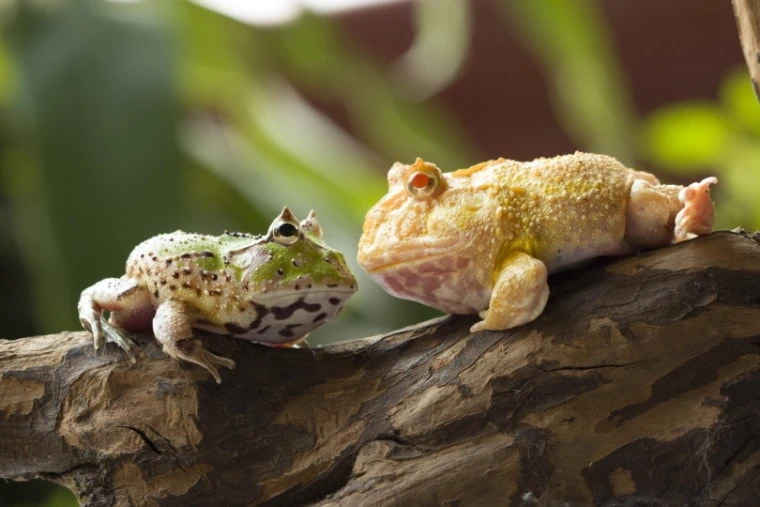The Pacman frog is a round, brightly colored, voracious eater.
These frogs have some of the most striking patterns and colors of any amphibian kept as a pet.
Colors ranging from red and orange to yellow and green and brown can be found among wild species.
Their ability to blend in with the dead leaves on forest floors is aided by these colorings.
Their large clutch sizes and ease of reproduction have resulted in a wide variety of new colors of Pacman frogs.
These Pac-Man morphs have completely different coloring and patterning than the original species.
Due to the abundance of color options, we have compiled a list of our favorite Pacman frog morphs.
What Are Pacman Frog Morphs?
The Ceratophrys Pacman frog is a South American species of burrowing frog.
Their horn-like crests above their eyes have earned them the alternative name of South American horned frogs.
They look like leaves thanks to their horns’ intricate patterns of red, orange, yellow, green, white, and brown.
They blend into the forest floor like a fallen leaf thanks to their camouflage of drab colors, random patterns, and horns.
This serves two purposes: it allows them to sneak up on unsuspecting prey and it protects them from danger.
The backs of wild Pacman frogs range from a uniform green to a rusty brown.
They’ll have a white underbelly with black dots and lines.
The Pacman frog family includes eight distinct species.
All eight species look nearly identical; the only real differences are in the details of their markings and the shape of their horn crests. Size, coloring, and horn crest shape are three characteristics that set species apart.
Cranwell’s horned frog has the most admirers (Ceratophrys Cranwell).
Breeders have created numerous color and pattern variations of this species in an effort to create even more spectacular Pacman frog morphs.
Sophisticated color and pattern combinations are the results of extensive selective breeding for these traits.
Frogs with distinct characteristics can be bred together to further emphasize those qualities in future offspring.
Because of this kind of selective breeding, there are now many morphs that don’t look like the typical wild species.
We’ve included photos of each Pacman frog morph below, highlighting the variations in pattern, coloration, and horn size and shape.
A-Z Pacman Frog Color List
| Morph | Color | Pattern | Price |
|---|---|---|---|
| Albino Pacman | Yellowish orange base with pink spots or markings | Small pink circular or oblong splotches | $25 to $125 |
| Blue Pacman | Aqua blue to algae green base with green and brown markings | Oblong splotches | $40 to $70 |
| Brown Pacman | Light brown base with brown markings | Chocolate colored splotches | $30 to $50 |
| Green Pacman | Brown to the green base with red, orange, yellow, and brown markings | Oblong splotches | $20 to $30 |
| Horned Pacman | Brown or green base with red, orange, yellow, and brown markings | Long abstract linear markings parallel to their spine | $65 to $100 |
| Ornate Pacman | Brown or green with red, yellow, and brown markings | Small circular or oblong splotches | $20 to $45 |
| Purple Pacman | Grey or purple base with brown markings | Milky brown splotches | $400 |
| Strawberry Pacman | Pink to orange with red, pink, and white marking | White or pink rings filled in with bright red | $35 to $50 |
| Translucent Pacman | Translucent pink | Species dependent | $400 |
| Yellow Pacman | Bright yellow base with red markings | Red oblong splotches | $70 to $100 |
Caring for Your Pacman Frog
Many people keep Pacman frogs as pets due to their attractive coloring and size (they can reach five or six inches in length).
Hobbyists have spent years carefully breeding different color morphs of Pacman frogs, and as a result, you can find them in a wide range of shades, from green to brown to albino to bright yellow to pink and even blue.
It has a huge appetite and will eat constantly for the rest of its 10-15 year lifespan if given the chance.
Some owners of this frog species may find it dull because it spends most of its time partially buried and as still as a statue while waiting for its prey to walk by, a strategy that allows it to catch more food.
If you’re looking for a pet that’s a lot of fun and never gets bored, a fire-bellied toad might be the way to go.
The Pacman Frog: A Good or Bad Pet for You?
Pros
- Care requirements are very simple.
- It needs very little space.
- It can be fed a variety of unique foods.
- The enclosure will be like having a tiny piece of nature in your home
- Technically, this species can be picked up and held
Cons
- Can be a boring species for a beginner frog keeper. It spends 95% of its time burrowed in the dirt, out of sight, doing absolutely nothing except waiting for food to walk by.
- Again, it doesn’t need much space because it spends all its time buried and/or sitting still
- Diet consists of LIVE feeder insects, which involves handling live bugs and very routine visits to the pet store to purchase bugs (unless you breed your own)
- The temperature and humidity will need to be closely monitored.
- ONLY AT YOUR OWN RISK! This species can be considered “aggressive” because it treats everything that moves as food, including your fingers. Bites can cause bleeding
Pacman Frog Morphs & Colors
1. Green “Normal” Pacman
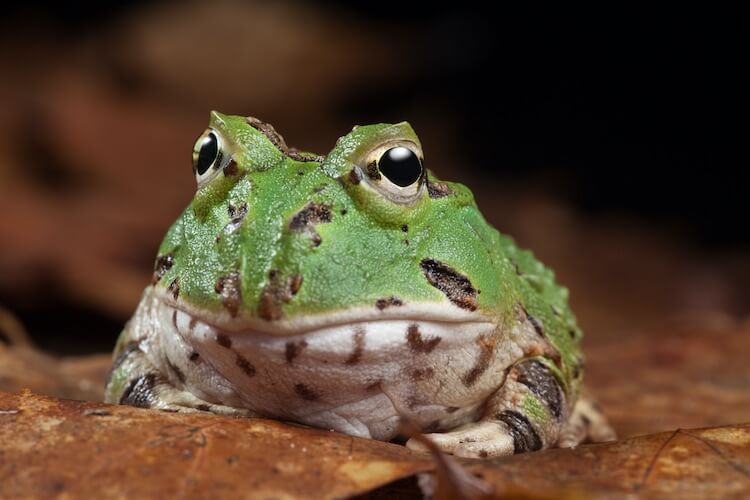
Regular old Pac-Man The “normal” Pacman frog morph or color is green.
Its entire body is covered in brown spots against a bright green background.
This is the most common frog coloration, as it is the standard for the species. These frogs are brown in nature, not green as depicted in some media.
2. Albino Pacman

Without pigment, the Pacman Frog is considered albino.
Because of this, its skin tone is very close to being yellow or orange.
Also like many other albino animals, its eyes are a striking shade of red.
The lack of pigment in these frogs makes it easy to see the intricate network of blood vessels beneath their skin.
Their coloration becomes muted and their eyes turn red.
3. Strawberry Pineapple Albino Pacman

The Pacman Frog is classified as albino because it lacks pigment. This causes its skin to have an appearance somewhere between a yellowish orange.
Similar to other albino animals, it has bright red eyes. Because these frogs lack pigment, the complex system of blood vessels beneath their skin is clearly visible.
Their eyes turn a bright red and their skin tones fade.
4. Chocolate Mint Pacman
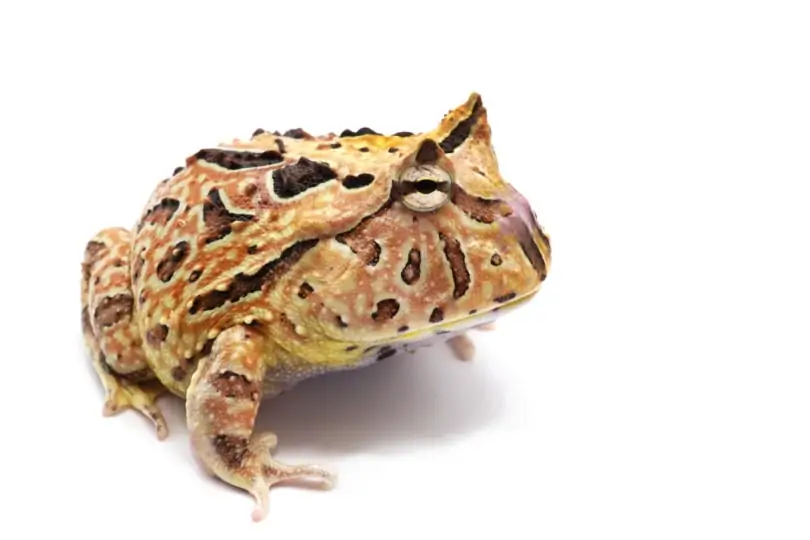
If it wasn’t obvious already, Pacman Frog breeders have a penchant for giving their frog morph names that reference tasty treats.
The Chocolate Mint Pacman’s green hue is much softer than that of the original Pacman. Additionally, it has lighter brown highlights.
5. Caatinga Pacman
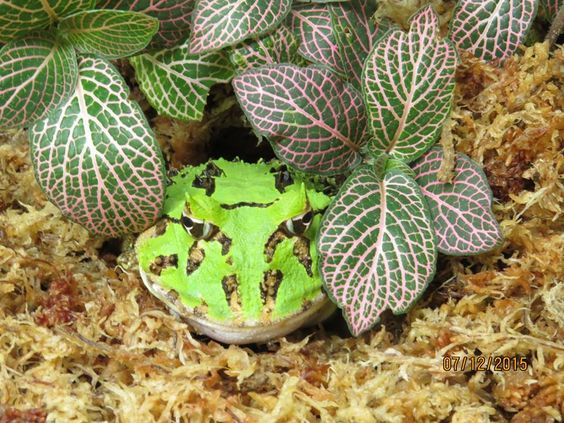
Caatinga Pac-Mans have an incredible amount of energy.
Although they can be found in a variety of hues, the most common is a vibrant green with brown spots.
These Pacman Frogs are among the liveliest and most enthusiastic of their kind.
6. Samurai Blue Line Ornate
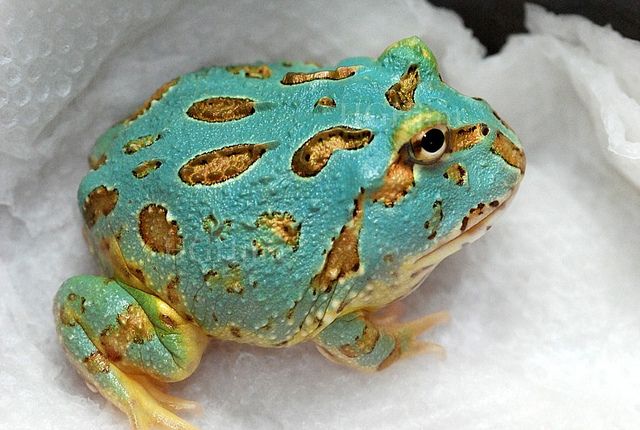
The Samurai Blue Line Ornate is the perfect Pac-Man for you if you enjoy the genre and prefer games that are both large and visually striking.
This morph is predominantly red, but it has a blue zigzag running the length of its body.
These frogs stand out due to their unusual appearance.
7. Samurai Lime Green Albino Pacman
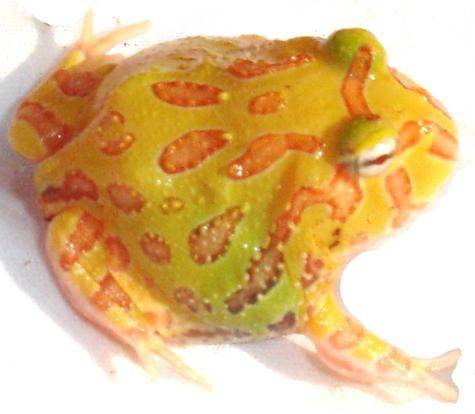
While the Samurai Lime Green Albino Pacman still has a green hue, its pattern and coloring are much less pronounced due to its albino pigmentation.
Each frog will have its own unique shade of color. The only green on some Samurai Lime Green Albinos is on their sides or the top of their eyes.
8. Samurai Apricot Albino Pacman
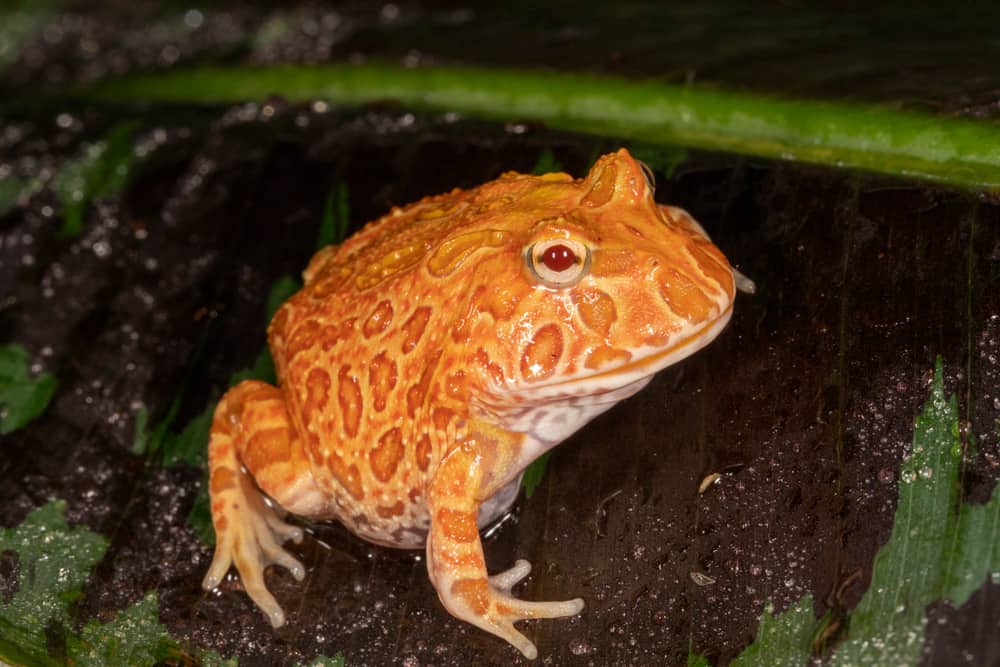
As one of the few frogs with a striking pattern of coloration, the Samurai Apricot Albino stands out. Their apricot color does not wear off as it does on other Albino Pacman.
They still display vivid hues, but they have red eyes and little to no other skin or hair pigmentation. Absolutely no other morph looks like this one.
9. Citrus Albino Pacman

This hybrid Pacman, known as the Citrus Albino, is an offspring of the aforementioned Samurai Lime Green Albino and the Samurai Apricot Albino.
These Pacman Frogs are typically very brightly colored, with a yellow body and orange spots. You won’t find another frog quite like this one.
10. High Red Ornate Pacman

The High Red ornate is a Pacman Frog with a lot of life.
Extremely brilliant, with pinpoints of brilliant red light. In the context of reptile and amphibian naming, “high” means “bright” or “a lot,” so this frog is called “high” because it has a lot of red.
11. Samurai Ornate
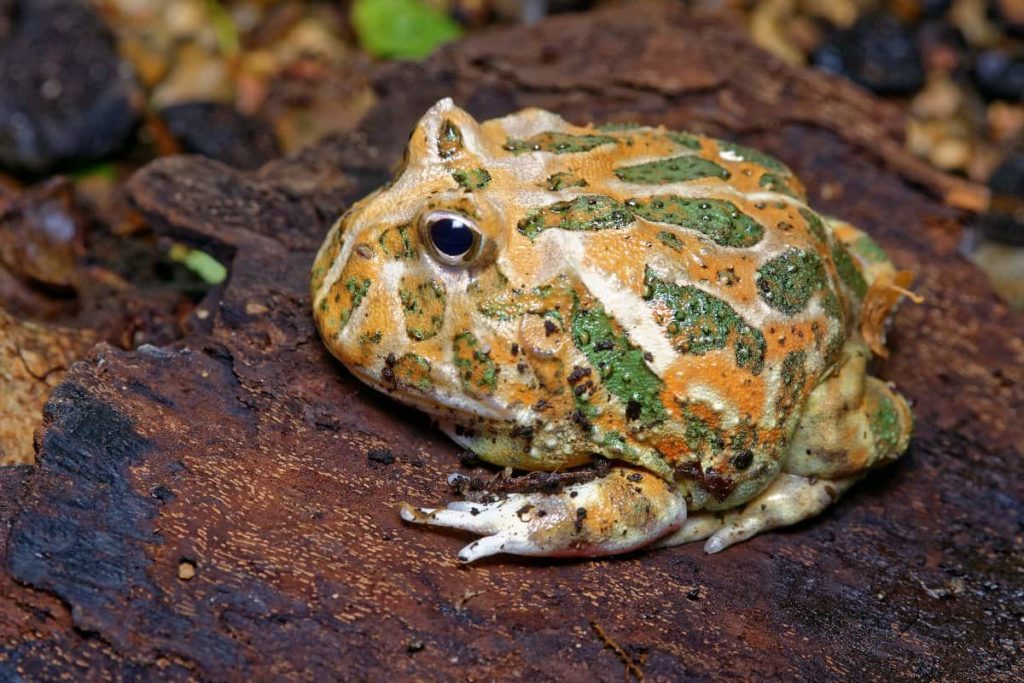
Samurai Ornates can be found in a wide variety of colors and designs, but the traditional colors of green and red are often prominent.
They’ll have brown spots, too. Similar to the other Ornate types, this one also has a plethora of decorative markings dotted all over its body.
